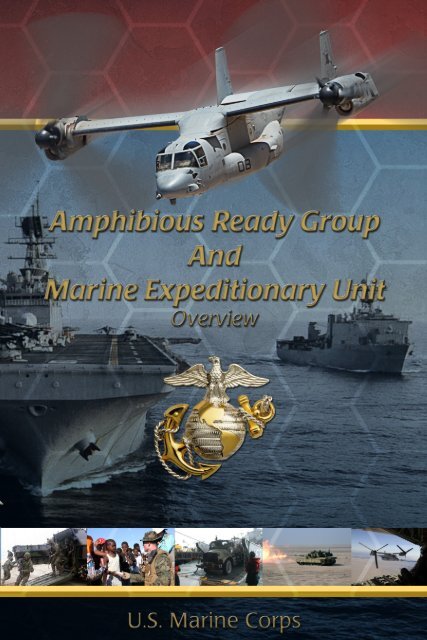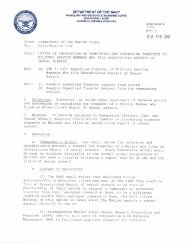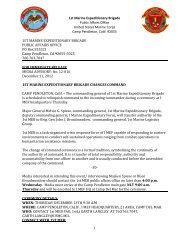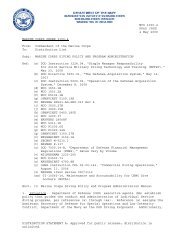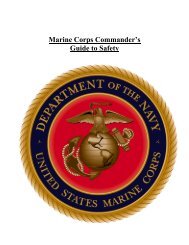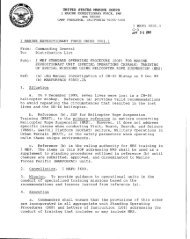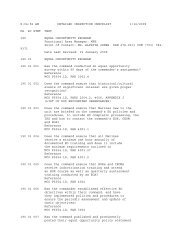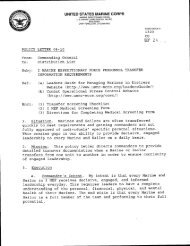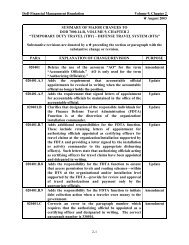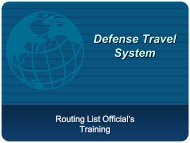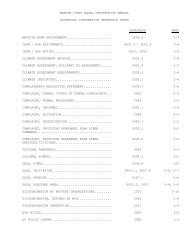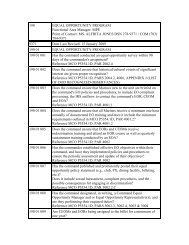Amphibious Ready Group and Marine Expeditionary Unit Overview
Amphibious Ready Group and Marine Expeditionary Unit Overview
Amphibious Ready Group and Marine Expeditionary Unit Overview
- No tags were found...
Create successful ePaper yourself
Turn your PDF publications into a flip-book with our unique Google optimized e-Paper software.
Table of ContentsThe US Strategic Challenge in an Era of Uncertainty 1<strong>Marine</strong> Air-Ground Task Force Defined 2Forward Deployed MEU Presence 3<strong>Marine</strong> <strong>Expeditionary</strong> <strong>Unit</strong> (MEU) 3Crisis Response/Partnering/Small Scale Contingencies 3MEU Mission 4MEU Mission Essential Tasks 5Navy-<strong>Marine</strong> Corps Team - <strong>Amphibious</strong> <strong>Ready</strong> <strong>Group</strong> (ARG) <strong>and</strong> MEU 6ARG/MEU Pre-Deployment Training Phase 7MEU Task Organization 8Comm<strong>and</strong> Element (CE) 8CE Capabilities 9Ground Combat Element (GCE) 10GCE Capabilities 10GCE Vehicles 10Aviation Combat Element (ACE) 12MEU Aircraft 12Logistics Combat Element (LCE) 14LCE Capabilities 14LCE Equipment 15Engineer Logistics 15ARG Capabilities 16ARG Task Organization 16PHIBRON 16NSE 17ARG/MEU Air, Sea, <strong>and</strong> Ground Mobility 18<strong>Amphibious</strong> Ships 20ARG/MEU Combined Capabilities 22Plan <strong>and</strong> Direct Intelligence Operations 22Intelligence Cycle 22Fires 23Fires Synchronization 23Aviation Fires 24Ground Fires 25Types of Projectiles Available 25Humanitarian Assistance 26Non-combatant Evacuation Operations 27Sea-based, Scalable, Flexible 28ARG/MEU Employment 30ARG/MEUHighly Relevant Force 31
The US Strategic ChallengeIn an Era of UncertaintyThe <strong>Unit</strong>ed States is increasingly challenged by the dem<strong>and</strong>s in thelittorals – the complex interface where the great commons of the sea meetthe physical geography where human, political, <strong>and</strong> economic domainsfunction.The Geo-Strategic Environment• 70% of the world is covered by water• 95% of all commercial cargo travels by sea• 49% of the world’s oil transits 6 major sea chokepoints• 23,000 ships are underway daily• 17 of the world’s 20 largest cities have direct access to the sea• 95% of international communications is transmitted by undersea cable• 75% of the world ‘s populace lives within 200 miles of a sea coastSources of Global Stress <strong>and</strong> Instability• Increasing resource scarcity <strong>and</strong> dem<strong>and</strong>• Poor or weak governance• Explosive mega-cities – most in the littorals• Population growths <strong>and</strong> unmet demographic expectations• Increasing ease of access to lethal technology• Networked terrorists/non-state actors• Growing near-peer global powers• Vulnerability of US expeditionary-dependent military posture to antiaccesscapabilities• American prosperity rests on a foundation of fair <strong>and</strong> free access to avibrant global economy• Disruptions to global commerce & access to the global commonsharm US <strong>and</strong> global economies• Instability reduces confidence in the international economic system<strong>and</strong> its legal framework• Freedom of action at sea <strong>and</strong> in the littorals are critical to securingUS national interests1
MAGTF DefinedThe <strong>Marine</strong> Air-Ground Task Force (MAGTF) is the <strong>Marine</strong> Corpsprincipal organizational construct for conducting missions across therange of military operations. MAGTFs provide combatant comm<strong>and</strong>erswith scalable, versatile expeditionary forces able to assure allies, deterpotential adversaries, provide persistent U.S. presence with little or nofootprint ashore, <strong>and</strong> respond to a broad range of contingency, crisis, <strong>and</strong>conflict situations. They are task organized, combined-arms force packagescontaining comm<strong>and</strong>, ground, aviation, <strong>and</strong> logistics elements. A singlecomm<strong>and</strong>er leads <strong>and</strong> coordinates this combined-arms team throughall phases of pre-deployment training, deployment, <strong>and</strong> employment.MAGTF teams live <strong>and</strong> train together further increasing their cohesion<strong>and</strong> fighting power.Multi-Mission Capable MAGTFsTailored to meet combatant comm<strong>and</strong>ers’ requirements, MAGTFs operateas an integrated force in the air, l<strong>and</strong>, maritime <strong>and</strong> cyberspace domains.The naval character of MAGTFs enhances their global mobility, lethality,<strong>and</strong> staying power. Embarked aboard amphibious ships or deployed usingother means, multi-mission capable MAGTFs provide U.S. civilian <strong>and</strong>military leaders with increased strategic <strong>and</strong> operational flexibility.Todays <strong>Amphibious</strong> CapabilityAmong the many capabilities provided by integrated, combat readyMAGTFs aboard multi-mission amphibious ships, three are of criticalimportance:• Forward presence to support engagement <strong>and</strong> theater securitycooperation• A ready force to immediately respond to emergent crises• A credible <strong>and</strong> sustainable forcible-entry capability, operating fromthe sea, over the horizon, at night or during periods of reducedvisibilityOur amphibious capability creates four strategic benefits for a nationdependent on its ability to exploit its comm<strong>and</strong> of the seas to projectinfluence <strong>and</strong> power:• Freedom of action: <strong>Amphibious</strong> forces can use the maritime domain asa base from which to conduct operations. They can loiter indefinitelyin international waters <strong>and</strong> maneuver ashore at the time <strong>and</strong> place oftheir choosing.2
• Deterrence: While a st<strong>and</strong>off strike is sometimes an adequateresponse, other situations require the rapid insertion of sustainablecombat forces – “boots on the ground” – to underscore the nationscommitment to an ally or to protect our National Security interests.• Assured access: <strong>Amphibious</strong> forces contribute unique <strong>and</strong> essentialcapabilities toward the nation’s ability to take advantage of thefreedom of the high seas to enter a region without regard to accessconstraints <strong>and</strong> impediments <strong>and</strong> to sustain sea-based operationsalmost indefinitely without need for in-theater host-governmentsupport.• Uncertainty for adversaries: A credible forcible-entry capabilitycompels potential adversaries to invest in a broad range of systems<strong>and</strong> spread their defenses over larger areas of concern.Forward Deployed MEU PresenceForward deployed MEUs embarked aboard <strong>Amphibious</strong> <strong>Ready</strong> <strong>Group</strong>s(ARGs) operate continuously in the areas of responsibility of variousGeographic Combatant Comm<strong>and</strong>ers (GCC). These units provide thePresident <strong>and</strong> the GCC with credible deterrence <strong>and</strong> decision time acrossthe range of military operations. MEUs serve as a forward-deployed,flexible sea-based MAGTF, capable of conducting amphibious operationsto respond to crisis, conduct limited contingency operations, introducefollow-on forces, <strong>and</strong> support designated special operations forces. MEUsare characterized by their sea-based forward presence, expeditionarynature, ability to plan for <strong>and</strong> respond to crises, combined armsintegration, <strong>and</strong> their interoperability with joint, combined <strong>and</strong> specialoperations forces.There are seven st<strong>and</strong>ing MEUs that routinely deploy in accordance withthe Global Force Management Implementation Guidance (GFMIG). TheCONUS-based MEUs are 11th, 13th <strong>and</strong> 15th from the West Coast <strong>and</strong> the22d, 24th, <strong>and</strong> 26th MEUs from the East Coast. The 31st MEU is forwardassigned <strong>and</strong> located in Okinawa, Japan.Crisis/Contingency Response• Deter aggression• Quickly respond to crisis• Protect citizens/interests• Exp<strong>and</strong> influence• Strengthen alliances• Conduct informationoperations3
Recent Examples:• Afghanistan• Libya• Pakistan• Haiti• Indonesia• Lebanon• Kosovo• Liberia• Philippines• U.S. Gulf Coast• Japan• New York CityMEU MissionProvide a forward deployed, flexible sea-based MAGTF capableof conducting amphibious operations, crisis response, <strong>and</strong> limitedcontingency operations, to include enabling the introduction of follow onforces, <strong>and</strong>, designated special operations, in order to support the theaterrequirements of GCCs.4
MEU Mission Essential Tasks<strong>Amphibious</strong> operations• <strong>Amphibious</strong> assault• <strong>Amphibious</strong> raid• Maritime interception Operations (MIO)/Visit, board, search, <strong>and</strong>seizure (VBSS)• Advance force operations<strong>Expeditionary</strong> support to other operations/crises <strong>and</strong> limited contingencyoperations — operating across the Range of Military Operations• Noncombatant Evacuation Operations (NEO)• Humanitarian assistance (HA)• Stability operations• Tactical Recovery of Aircraft<strong>and</strong> Personnel (TRAP)• Joint <strong>and</strong> combined operations• Aviation operations fromexpeditionary shore-based sites• Theater security cooperationactivities• Airfield/port seizureMEU CharacteristicsMost agile, st<strong>and</strong>ing <strong>Marine</strong> Air Ground TaskForce (MAGTF)• <strong>Expeditionary</strong> by nature• Sea-based, strategic reach with inherent force protection• Scalable levels of presence <strong>and</strong> visibility• Offers wide range of options for the national leadership• Rapid response: within 6 hours of notification• Self-sustaining: 15 days of organic, sea-based logistics• Task organized to operate across the Range Of Military Operations(ROMO)• Enables follow-on, joint, interagency, <strong>and</strong> coalition forces• Combined arms integration of credible combat power• Operates from over-the-horizon <strong>and</strong> out-of-sight• Operates independent of facilities ashore• Capable of integrating with special operations forces5
Navy-<strong>Marine</strong> Corps Team<strong>Amphibious</strong> <strong>Ready</strong> <strong>Group</strong> (ARG) <strong>and</strong> MEUSupported/Supporting Relationship<strong>Amphibious</strong> Squadron(PHIBRON)CE(MEU)<strong>Amphibious</strong> Assault Ship(LHD or LHA)Naval SupportElement (NSE)GCE(Battalion L<strong>and</strong>ing Team)<strong>Amphibious</strong> Transport Dock(LPD)ACE(Composite Squadron)Dock L<strong>and</strong>ing Ship(LSD)LCE(Combat Logistics Battalion)6
ARG/MEU Pre-Deployment Training PhaseCritical for building the Blue-Green team <strong>and</strong> capabilitySt<strong>and</strong>ardized 6-month, phased, pre-deployment training phase in CONUS2 monthsInitial Training Phase• ARG/MEU staff planning• Individual <strong>and</strong> special skills training3 monthsIntermediate Training Phase• Phibron/MEU integration training (at-sea)• Realistic urban training• Composite training unit (at-sea)• MEU/SOF interoperability training1 monthFinal Training Phase• Supporting arms coordination• Certification (at-sea)• Pre-overseas movementBuilding block approachIndividual skillsSpecial skillsCollective skills7
MEU Task OrganizationMEUComm<strong>and</strong> Element(CE)169 <strong>Marine</strong>s <strong>and</strong> Sailors2,059 <strong>Marine</strong>s <strong>and</strong> Sailors** Based on current MEU Policy OrderGroundCombat Element(GCE)Reinforced Infantry Battalion1,200 <strong>Marine</strong>s <strong>and</strong> SailorsAviationCombat Element(ACE)Composite Squadron417 <strong>Marine</strong>s <strong>and</strong> SailorsLogisticsCombat Element(LCE)Combat Logistics Battalion273 <strong>Marine</strong>s <strong>and</strong> SailorsComm<strong>and</strong> Element (CE)(169 <strong>Marine</strong>s <strong>and</strong> Sailors)The CE contains the MAGTF headquarters <strong>and</strong> other units thatprovide intelligence, communications, <strong>and</strong> administrative support. TheCE is scalable <strong>and</strong> task organized to provide the comm<strong>and</strong>, control,communications, computers, intelligence (C4I), <strong>and</strong> joint interoperabilitynecessary for effective planning <strong>and</strong> executions of operations.• Force Reconnaissance Platoon• Air Naval Gunfire Detachment• Imagery Interpretation Detachment• Human Exploitation Detachment• Ground Sensor Detachment• Topographic Detachment• Radio Detachment• Communication Detachment• <strong>Marine</strong> Corps InformationOperations Center (MCIOC)Team8
MEU Comm<strong>and</strong> Element Capabilities• Rapid <strong>and</strong> deliberate planning• Comm<strong>and</strong> <strong>and</strong> Control (C2)• Enable Joint Task Force (JTF)<strong>and</strong> maritime prepositioningforce operations• Reconnaissance & Surveillance(R&S)• Human intelligence collection• Signals intelligence collection• Geospatial intelligence/analysis• Imagery intelligence collection• Ground sensor employment• MIO/VBSS• Integrate <strong>and</strong> synchronize MEU,naval, joint, <strong>and</strong> combined fires• Military information supportoperations9
Ground Combat Element (GCE)The GCE is task organized toconduct ground operations tosupport the MAGTF mission. Thiselement includes infantry, artillery,reconnaissance, armor, light armor,assault amphibian, engineer, <strong>and</strong>other forces as needed.Battalion L<strong>and</strong>ing Team (BLT)(~1,200 <strong>Marine</strong>s <strong>and</strong> Sailors)• Headquarters & ServiceCompany• 3 x Rifle Company• Weapons Company• Artillery Battery• <strong>Amphibious</strong> Assault Vehicle(AAV) Platoon• Light Armored ReconnaissancePlatoon or Company (-)• Tank Platoon• Engineer Platoon• Reconnaissance PlatoonCapabilities• <strong>Amphibious</strong> assaults• <strong>Amphibious</strong> raids• Airfield seizure• Offensive operations• Defensive operations• Stability operations• NEO• MIO/VBSS• HA• TRAP• R&SGCE Vehicles4 x M1A1 Main Battle Tank(In addition, LCE has 1 x M88A12Tank Retriever)• Crew: 4• Speed: 42 mph• Range: 275 miles• Main armament:120 mm (40 rounds)• Secondary:1 x 12.7mm, 2 x 7.62mm15 x Assault <strong>Amphibious</strong> Vehicle(AAV)• personnel <strong>and</strong> comm<strong>and</strong>variants• Troops: 3 Crew + 21 combat<strong>Marine</strong>s• Speed: 45 mph (7 kts in water)• Range: 200 miles• Armament:1 x 12.7mm machinegun1 x 40mm grenade launcher10
8-17 x M1161 InternallyTransportable Vehicles (ITV)• Transportable inside MV-22/CH-53E• Troops: 4• Speed: 65 mph• Range: 170 miles• Armament:1 x 12.7 mm machinegunor 1 x 40mm grenade launcher31 x Medium Tactical Vehicles• Cargo: 7 tons off-road/15 tonspaved• Troops: 25• Speed: 65 mph• Range: 360 miles• Armament: 1 x 12.7 mmor 40mm grenade launcher or7.62 mm7-17 x Light Armored Vehicle (LAV)(In addition, MEU has 1 x MobileElectronic Warfare LAV)• Troops: 3 Crew + 4 Troops• Speed: 60+ mph• Range: 400 miles• Armament:1 x 25 mm cannon,2 x 7.62 mm machineguns,or TOW variant105 x High Mobility Multi-WheeledVehicles (HMMWV)• Troops: 4 - 10• Speed: 55 – 70 mph• Range: 256 – 350 miles• Armament:1 x 12.7 mmor 40mm grenade launcheror 7.62 mm machinegunsor TOW missile11
Aviation Combat ElementThe ACE conducts offensive,defensive, <strong>and</strong> all other airoperations to support the MAGTFmission.5 of 6 Aviation Functions• Control of aircraft <strong>and</strong> missiles• Assault support• Offensive air support• Anti-aircraft warfare• Aerial reconnaissanceComposite Squadron(~417 <strong>Marine</strong>s <strong>and</strong> Sailors)• Medium Tilt-rotor Squadron• Light Attack Helo Detachment• Fixed Wing Detachment• Heavy Helo Detachment• Aviation Logistics Detachment• Aviation Support Squadron• Air Control Detachment• Aerial Refuel DetachmentMEU Aircraft12 x MV-22B/C Osprey• Medium lift assault support• 24 combat equipped <strong>Marine</strong>s• 10,000 lbs external load• Cruise speed: 240 knots• Combat radius: 325 NMw/o refuel• Aerial refuel capable4 x CH-53E Super Stallion• Heavy lift assault support• 24 combat equipped <strong>Marine</strong>s(can lift up to 55 passengers)• 36,000 lbs external load• Cruise speed: 120 knots• Combat radius: 225 NMw/o refuel• Aerial refuel capable12
3 x UH-1Y Huey• Comm<strong>and</strong> <strong>and</strong> Control• 8 combat equipped <strong>Marine</strong>s• Cruise speed: 147 knots• Combat radius: 129 NM2 x Hercules (KC-130J)• Aerial refueling• On-call, CONUS st<strong>and</strong>-by• Cruise speed: 320 kts• Combat radius: 3,345 NM4 x AH-1Z• Rotary Wing CAS• Cruise speed: 137 knots• Combat radius: 125 NM6 x Harrier (AV-8B)• Fixed Wing CAS• Vertical Short Takeoff/L<strong>and</strong>ings (VSTOL)• Max speed: 585 kts• Combat radius: 300 NM5 x RQ-21A Small TacticalUnmanned Air System (STUAS)• Intelligence, Surveillance, <strong>and</strong>Reconnaissance (ISR)• Communication relay• Ship or l<strong>and</strong>-based• Control radius: 50 NM• Max speed: 80 kts• Endurance: 10 hrs• To be fielded 2014-201513
Logistics Combat Element (LCE)The LCE is task-organized to providethe full range of combat logisticsfunctions <strong>and</strong> capabilities necessary tomaintain the continued readiness <strong>and</strong>sustainability of the MAGTF as a whole.Combat Logistics Battalion (CLB)(~273 <strong>Marine</strong>s <strong>and</strong> Sailors)• Headquarters Platoon• Law Enforcement Detachment• Maintenance Detachment• Medical Detachment• Engineer Platoon• Communications Platoon• EOD Detachment• Supply Detachment• L<strong>and</strong>ing Support PlatoonCapabilities• 15 days organic sustainment• Ground supply operations• Ground equipment maintenance –intermediate level• Transportation operations• General engineering operations• Earth moving• Construction & repair• Electrical support• Water purification, <strong>and</strong>distribution• Health services• Explosive Ordnance Disposal (EOD)• General services (postal, ammo)• Humanitarian assistance• Evacuation control centeroperations• Law enforcement operations14
LCE Equipment• 15 MTVR• 18 HMMWVs• 2 wreckers• 2 bulldozers• 3 forklifts• 4 bulk fuel trucks• 2 water trucks• 2-5 water purification systems• 1 tank retriever• 1 recovery AAV• 2 NEO Tracking Systems (NTS)Engineer LogisticsWater Section• 1,200 gal per hour(24k gal per 10 hour day) – purification• 5,400 gal mobile – distribution/storage• 30,000 gal static – storageElectrical Section• Generators (various sizes)• Floodlight sets• Power distribution (various sizes)• Refrigeration units (various)• Trailers (various)Combat Engineer Section• Village water cisternreinforcement• Vertical building• Roof replacement• Debris removal15
<strong>Amphibious</strong> <strong>Ready</strong> <strong>Group</strong>The <strong>Amphibious</strong> <strong>Ready</strong> <strong>Group</strong> (ARG) is the most frequently employedtype of amphibious task force (ATF) organization that is formed to conductamphibious operations. Together <strong>and</strong> in close cooperation with the MEU,who is the L<strong>and</strong>ing Force (LF) embarked aboard the ships of the ARG,collectively they comprise an <strong>Amphibious</strong> Force (AF). An ARG consistsof a minimum of three ships, usually an amphibious assault ship (LHD orLHA), an amphibious transport dock ship (LPD) <strong>and</strong> an amphibious dockl<strong>and</strong>ing ship (LSD). In addition to the ships, the principal Navy elementsof the ARG are a Naval Beach <strong>Group</strong> element that includes Beachmasterswho control the movement of personnel <strong>and</strong> equipment across the beach,Assault Craft <strong>Unit</strong> (ACU) elements that bring the l<strong>and</strong>ing craft, bothL<strong>and</strong>ing Craft Air Cushion (LCAC) <strong>and</strong> L<strong>and</strong>ing Craft Utility (LCU) thatmove equipment <strong>and</strong> personnel from the ship to the shore, the TacticalAir Control Squadron (TACRON) element that provides aviation control,a Fleet Surgical Team (FST) that provides enhanced medical support <strong>and</strong>a Helicopter Sea Combat Squadron (HSC) element that provides airbornesearch <strong>and</strong> rescue, vertical replenishment, air <strong>and</strong> sea defense <strong>and</strong> limitedassault support. A single comm<strong>and</strong>er, a Navy Captain referred to as theCommodore, leads <strong>and</strong> coordinates the Navy team through its entiretraining plan. The ARG/MEU forms a cohesive Navy/<strong>Marine</strong> Corpscombined-arms team ready to respond to all missions across the range ofmilitary operations.ARG Capabilities• Comm<strong>and</strong> <strong>and</strong> control• Operational maneuver• <strong>Amphibious</strong> assault, demonstration, withdrawal• Intelligence, surveillance, reconnaissance• Joint intelligence operations• Logistical support• Mass casualty & level II surgery• SOF integration• MIO/VBSS• NEO• HA• Water Production• LHA/D 200,000 gallons / day• LSD60,000 gallons / day• LPD 17 72,000 gallons / day16
ARG Task OrganizationPHIBRON<strong>Amphibious</strong> Squadron Staff• 33 personnel• Planning• C2Tactical Air Control Squadron Detachment• 29 personnel• Control tactical air operationsFleet Surgical Team• 18 personnel• 1 surgeon/2 physicians• Surgical <strong>and</strong> medical supportNSEHelicopter Sea Combat Squadron (HSC) Detachment• 29 personnel• Search <strong>and</strong> rescue• Anti-surface warfare• LogisticsL<strong>and</strong>ing Craft Air Cushion (LCAC)• 34-54 personnel• Speed: 35 knots• Can l<strong>and</strong> over 80% of the world’s beaches• Limited to beach ops• Medium cargo lift• 1 M1A1 tank or 2 MTVRs or 4 LAVsor 180 personnelL<strong>and</strong>ing Craft Utility (LCU)• 12-24 personnel• Speed: 10 knots• Large Cargo Lift• 2 M1A1 tank or 4 MTVRs or 9 LAVsor 300 personnel• Can operate in ports <strong>and</strong> harbors• Limited by beach gradientsBeachmaster <strong>Unit</strong> Detachment• 25 personnel• Beach traffic control• Surf zone salvageARG/MEU Air, Sea, <strong>and</strong> Ground Mobility~2,000 ARG Personnel, ~2,059 MEU Personnel17
<strong>Amphibious</strong> ShipsWasp ClassUSS Wasp (LHD 1)USS Essex (LHD 2)USS Kearsarge (LHD 3)USS Boxer (LHD 4)USS Bataan (LHD 5)USS Bonhomme Richard (LHD 6)USS Iwo Jima (LHD 7)USS Makin Isl<strong>and</strong> (LHD 8)• 40,650+ tons• 22 knots• Crew: 1,123• Troops: 1,687(+184 surge)• 20,000 square ftvehicle storage• 125,000 cubic ftcargo storage• 9 l<strong>and</strong>ing spots &aircraft hangar• 3 LCACs or 2 LCUs• 536,343 gal JP-5• 6 operating rooms• 64 hospital bedsAmerica ClassUSS America (LHA 6)USS Tripoli (LHA 7)** Ship under construction• 44,850 tons• 22 knots• Crew: 1,059• Troops: 1,687(+184 surge)• 12,000 square ftvehicle storage• 160,000 cubic ftcargo storage• 9 l<strong>and</strong>ing spots &aircraft hangar• No well deck• 1,300,000 gal JP-5• 2 operating rooms• 24 hospital beds* USS Peleliu (LHA 5) remains inservice until end of FY15San Antonio ClassUSS San Antonio (LPD 17)USS New Orleans (LPD 18)USS Mesa Verde (LPD 19)USS Green Bay (LPD 20)USS New York (LPD 21)USS San Diego (LPD 22)USS Anchorage (LPD 23)USS Arlington (LPD 24)USS Somerset (LPD 25)USS John P. Murtha (LPD 26)*USS Portl<strong>and</strong> (LPD 27)** Ship under construction*USS Denver (LPD 9) remains inservice until end of FY14• 25,885 tons• 22 knots• Crew: 360• Troops: 720(+80 surge)• 24,000 square ftvehicle storage• 34,000 cubic ftcargo storage• *4 l<strong>and</strong>ing spots &aircraft hangar• 2 LCACs or 1 LCU• 318,308 gal JP-5• 24 hospital beds*LPD-17 class has 2 st<strong>and</strong>ard helo spots <strong>and</strong> 4 exp<strong>and</strong>ed spots based on the type, model, <strong>and</strong> series of aircraft embarked20
Whidbey Isl<strong>and</strong> ClassUSS Whidbey Isl<strong>and</strong> (LSD 41)USS Germantown (LSD 42)USS Fort McHenry (LSD 43)USS Gunston Hall (LSD 44)Harpers Ferry ClassUSS Harpers Ferry (LSD 49)USS Carter Hall (LSD 50)USS Oak Hill (LSD 51)USS Pearl Harbor (LSD 52)USS Comstock (LSD 45)USS Tortuga (LSD 46)USS Rushmore (LSD 47)USS Ashl<strong>and</strong> (LSD 48)• 15,939 tons• 22 knots• Crew: 413• Troops: 402(+102 surge)• 12,500 square ftvehicle storage• 5,000 cubic ftcargo storage• 2 l<strong>and</strong>ing spots• 4 LCACs or 3 LCUs• 52,160 gal JP-5• 8 hospital beds• 16,740 tons• 22 knots• Crew: 419• Troops: 402(+102 surge)• 20,200 square ftvehicle storage• 67,600 cubic ftcargo storage• 2 l<strong>and</strong>ing spots• 2 LCACs• 51,923 gal JP-5• 11 hospital beds21
ARG/MEU Combined CapabilitiesPlan <strong>and</strong> Direct Intelligence OperationsThe ARG <strong>and</strong> MEU form a cohesive intelligence team, operating fromthe LHD Joint Intelligence Center (JIC). The team draws on bothstrategic, operational, <strong>and</strong> tactical intelligence resources <strong>and</strong>, in certaincircumstances, conducts intelligence operations for the operational <strong>and</strong>strategic levels. The ARG <strong>and</strong> MEU conduct the six intelligence functionscontinuously during the planning, decision, execution, <strong>and</strong> assessmentcycles of mission planningIntelligence CycleCoordinate to leverage intelligence capabilities outside the ARG-MEU:• Other naval intelligence platforms/systems• Theater intelligence systems• National intelligence systems• Plan Intelligence activities to support operations• Deploy collection capabilitiesCollect, process, <strong>and</strong> exploit intelligence:• Signals intelligence (SIGINT)• Human intelligence (HUMINT)• Imagery intelligence (IMINT)• Ground sensors• Force reconnaissance22
FiresEach ARG/MEU conducts extensive integrated supporting arm training.During the PTP the ARG/MEU use both assets inherent with the MEU<strong>and</strong> those from external cources, such as Naval Surface Fire Support ships,<strong>and</strong> when available, Carrier Strike <strong>Group</strong> (CSG) aviation <strong>and</strong> joint assets.MEUs deploy with the ability to plan, coordinate <strong>and</strong> control fires in thejoint/combined environment.Fires SynchronizationMEU/ARG Fires Integration & Coordination• Integrate fires with scheme of maneuver• Integrate both kinetic <strong>and</strong> non-kinetic fires• Access <strong>and</strong> leverage other forward deployednaval, joint, coalition fires:• Carrier strike <strong>and</strong> jamming aircraft• Naval gunfire <strong>and</strong> missiles• Air Force <strong>and</strong> Army aircraft• Army ground fires• Allied <strong>and</strong> coalition aircraft <strong>and</strong> weapons• Electronic attack• Coordination centers able to effectivelycontrol fires from ARG shipping as wellas ashore• Multiple, highly trained controllers<strong>and</strong> observers• 13 Joint Terminal Attack Controllers/AirControllers• 8 Joint Fires Observers/Navalgunfire observers• 12 artillery <strong>and</strong> mortar observers23
Aviation FiresGun(s)RocketsAir-to-AirMissileAir-to-GroundMissilesGeneralPurposeBombsGuidanceKits forGP BombsAdditionalBombsAV-8B 25mm2.75 inch5.0 inchSidewinderAMRAAMMaverick500 lbs.1000 lbs.LaserGPSIncendiaryClusterMinesKC-130J(w/ HarvestHawk)HellfireGriffinHellfireGriffinAH-1Z 20mm 2.75 inch Sidewinder HellfireUH-1Y 7.62mm 2.75 inchARG ships carry 15 days of ammunition for embarked aircraft24
Ground FiresMEUs deploy with either: 6 x 155mm M777 howitzers or 6 x 120mm M327towed mortars or a combination of both6 x M777A2 Howitzer• 155 mm• Range: 30 km• Weight: 9,300 lbs6 x M327 Rifled Mortar• 120 mm• Range: 8.2 km• Weight: 1,800 lbs• (MV-22 internally transportable)8 x M252 Mortar• 81 mm• Range: 6.0 km• Weight: 91 lbs9 x M224 Mortar• 60 mm• Range: 3.5 km• Weight: 47 lbsTypes of Projectiles AvailableCaliber(mm)Range(km)Coverage(km2)HighExplosiveDualPurposeImproved(Cluster)MinefieldLaserGuidedGPSGuidedSmokeIlluminationGasM777 155 30 2,827 X X X X X X X XM327 120 8.2 211 X X XM252 81 6.0 113 X X X & IRM224 60 3.5 38 X X X & IRARG ships carry 15 days of ammunition for embarked weapons25
Humanitarian AssistanceThe ARG/MEU team can providesignificant assistance in response tohumanitarian <strong>and</strong> disaster events.MedicalARG• 7 physicians <strong>and</strong> 3 dentists• 5-9 operating rooms• 7-25 intensive care beds• 730-800 ward <strong>and</strong> triage bedsMEU• 2 physicians <strong>and</strong>2 physician assistants• 78 corpsmen• Shock trauma platoon• 30-bed evacuation ward• casualty evacuationWaterARG• Produce 332,000 gallons ofpotable water per day at seaGeneral EngineeringMEU• Mobile power generators• Bulldozers <strong>and</strong> excavator• ForkliftsTransport <strong>and</strong> DistributionARG• 4-7 LCAC <strong>and</strong> LCUs• 2 medium lift helicoptersMEU• 16 medium <strong>and</strong> heavy lifthelicopters• 15 AAVs• 38 medium lift trucksARG/MEU capabilities are selfsupporting<strong>and</strong> have minimal impacton a fractured infrastructure:• Berthing <strong>and</strong> feeding of teamsaboard ship• Aircraft basing on ships• Self-contained l<strong>and</strong>ing craftfacilities (well-decks)• Significant communications<strong>and</strong> C2 facilitiesMEU• Produce 24,000 gallons ofpotable water per day ashore26
Non-combatant Evacuation Operations—Globally Protecting US CitizensForward deployed; ready to assistIn the past twenty years over 20,000American <strong>and</strong> partner nation citizenswhose lives were in danger in a hostnation have been evacuated byU.S. <strong>Marine</strong>s from amphibious shipsto a safe havenNon-combatant Evacuation Operations (NEO)EvacueesOperation Location Year US TotalLebanon NEO 2006 Lebanon 2006 14,000Safe Departure Asmara, Eritrea 1998 105 172Noble Obelisk Sierra Leone 1997 451 2,510Guardian RetrievalCongo(formerly Zaire)1997 532Silver Wake Albania 1997 900Quick Response Central African Republic 1996 208 448Assured Response Liberia 1996 480 2,780Distant Runner Rw<strong>and</strong>a 1994 148 230Eastern Exit Somalia 1991 281Sharp Edge Liberia 1990 330 3,02027
Sea-based, Scalable, Flexible Engagement CapabilityComprehensive range of engageme28
nt with minimal footprint ashore29
ARG/MEU EmploymentAn ARG/MEU is best employed as designed—as a single entity. As such,they are not only capable of conducting the full range of missions, theycan conduct many of them simultaneously <strong>and</strong>/or in rapid succession inaccordance with GCC priorities <strong>and</strong> emerging crises. Given the increaseddem<strong>and</strong> for military engagement, security cooperation <strong>and</strong> crisis responsecapabilities, GCCs may choose to employ tactics that involve greaterdispersion of the ships at sea <strong>and</strong> the conduct of littoral maneuver.Additionally, operational necessity may occasionally require ARG/MEUsto be divided into smaller, more widely separated formations. Doingso imposes risk <strong>and</strong> is not the preferred method of employment. Whenoperational necessity makes such risks acceptable, an ARG/MEU mayoperate in a split or disaggregated manner.Split operations require elements of the ARG/MEU to function separatelyfor short durations <strong>and</strong>/or distances, with the PHIBRON <strong>and</strong> MEUcomm<strong>and</strong>ers retaining control of all forces under the same GCC.Disaggregated operations require elements of the ARG/MEU to functionseparately <strong>and</strong> independently, regardless of time <strong>and</strong> distance, withelements under a comm<strong>and</strong> relationship that changes/limits the PHIBRON<strong>and</strong> MEU comm<strong>and</strong>ers’ control of their forces. The ARG/MEU may bedisaggregated within a GCC’s AOR or elements of the ARG/MEU may beattached to a different GCC.Although ARG/MEUs are highly capable <strong>and</strong> flexible organizations, thereare some limitations on key enablers that constrain tactics <strong>and</strong> employmentoptions if required to operate in a split or disaggregated manner.Augmentation of medical, intelligence, aviation, <strong>and</strong> beach support partypersonnel <strong>and</strong> equipment may be required to continue to meet operationalrequirements under these circumstances. Other key considerations forsplit or disaggregated employment of the ARG/MEU are the diminishmentof ground, aviation <strong>and</strong> overall comm<strong>and</strong> <strong>and</strong> control capability becauseof reduced C5I capacity aboard the LPD <strong>and</strong> LSD, fewer aviation <strong>and</strong>surface ship to shore connectors on a single ship or pair of ships resultingin a slower ability to move personnel <strong>and</strong> equipment or mass combatpower ashore, no fixed wing aviation <strong>and</strong> a consequent reduction inaviation delivered fires <strong>and</strong> ISR, spreading the Maritime Raid Force <strong>and</strong> itsmaritime interception operations <strong>and</strong> precision raid capabilities such that itis less effective than when aggregated. Heavy ground fires capabilities suchas tanks or towed artillery are difficult to move between ships. Aviation30
SAR capability with two H-60’s will be severely taxed, explosive ordnancedisposal will have limited to no capacity to operate on two or more ships<strong>and</strong> ashore concurrently <strong>and</strong> aviation maintenance aboard ships other thanthe LHD/LHA can only be sustained for a finite amount of time. The FSTwill have to reorganize <strong>and</strong> receive augmentation from the MEU’s ShockTrauma Platoon to provide Level II medical capability on multiple ships.The PHIBRON <strong>and</strong> MEU comm<strong>and</strong>ers carefully analyze <strong>and</strong> retaskorganize their forces on each ship to best meet the anticipatedrequirements while operating in a split or disaggregated fashion. Thenimbleness of the ARG/MEU team allows these forces to be organized <strong>and</strong>reorganized quickly <strong>and</strong> efficiently, within reason, even over significantdistances.Split/Disaggregated Operations ExampleThe real world example of the Peleliu ARG/15th MEU is illustrativeof the extraordinarily capable fashion that the ARG/MEU can operatewhile disaggregated <strong>and</strong> of the risk involved. On September 9, 2010PELARG/15th MEU successfully executed three simultaneous combat <strong>and</strong>foreign humanitarian assistance (FHA) operations. The LHA (Peleliu) <strong>and</strong>LSD (Pearl Harbor) were in an operations box (OPBOX) off the coast ofPakistan operating as CTG 51.3 (ARG) <strong>and</strong> CTG 51.5 (MEU) in supportof FHA for flood relief throughout Pakistan. That day over 16 ARG/MEUhelicopters operated ashore <strong>and</strong> afloat providing relief while an ARG/MEUforward comm<strong>and</strong> element (FCE) of several personnel acted as a liaisonto the American embassy in Karachi for the coordination of relief efforts.Simultaneously, four two-aircraft formations of AV-8B jets launched fromthe deck of the Peleliu to conduct offensive air support (OAS) missionsin support of Operation ENDURING FREEDOM in Afghanistan. Onthis day they delivered six GBU-54 laser JDAM 500 pound bombs againstenemy targets while also refueling from MEU KC-130J aerial tankers bothenroute <strong>and</strong> during return from the targets. Simultaneously, over 1,700miles away in the Gulf of Aden (GOA) while under the tactical control ofCTF 151, the LPD (Dubuque) conducted an opposed visit, board, search<strong>and</strong> seizure (VBSS) of the MV Magellan Star, freeing its crew <strong>and</strong> the shipfrom the control of Somali pirates. The MEU Comm<strong>and</strong>ing Officer <strong>and</strong>the PHIBRON Comm<strong>and</strong>er retained full situational awareness of all threeevents, comm<strong>and</strong>ing <strong>and</strong> controlling the FHA effort in Pakistan, providingguidance to the VBSS in the GOA <strong>and</strong> providing direct support to the OASmissions in Afghanistan.31
The risk incurred was specific to each mission. The FHA lacked thesurface connectors (LCACs) the LPD carried with her, diminishing thecapability to more quickly move relief supplies ashore. The VBSS did nothave any fixed wing aviation support nor complete rotary wing aircraftsupport, lessening an integral part of the tactics for a VBSS. The medicalcapability aboard the LPD was not Level II, since the ARG/MEU didnot have that capacity, but a supporting coalition ship of CTF 151 madeup for that shortfall, a luxury not always present. Even so, the risk wasmanageable <strong>and</strong> the missions were accomplished successfully. The savvyreconfiguration of forces <strong>and</strong> equipment aboard all three ships of the ARGby the PHIBRON <strong>and</strong> MEU made these actions possible <strong>and</strong> demonstratethe remarkable operational relevance the ARG/MEU brings to the range ofmilitary operations.ARG/MEU Highly Relevant ForceEngage Respond ProjectFlexibility to respond to global instability <strong>and</strong> enabling maximumfreedom of action with the least risk• Versatile, sea-based capability for the era of uncertainty• Proven, flexible utility in peace <strong>and</strong> conflict• Leverages our comm<strong>and</strong> of the seas to build necessary partnership,exert timely influence, <strong>and</strong> deter conflict• Forward to respond to crises with a variety of essential capabilities• Enables strategic conditions for an expeditionary-dependent military32
For more information visit:http://www.imef.marines.mil/news/meuoverview.aspx


